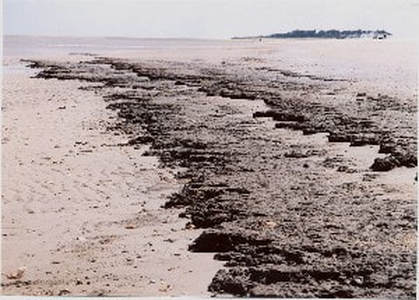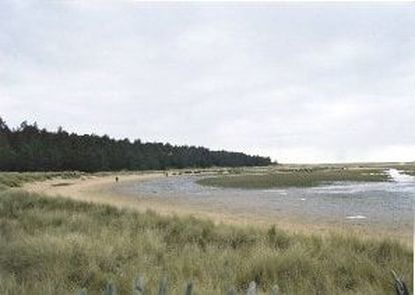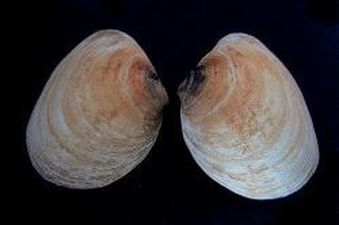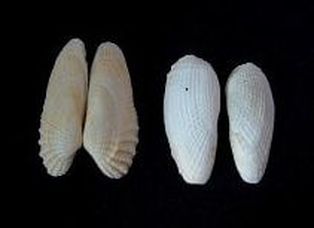North Norfolk beaches
by Selina Wilkins
Photography by Selina Wilkins
Photography by Selina Wilkins
I have shelled extensively at Wells, Holkham, Brancaster and Titchwell beaches in the last five years. They are on the North Norfolk coast, a superb stretch of golden sand heading towards the Wash at Hunstanton. The shell species they support vary due to their habitat. In this article I'll describe each beach in turn, and the list summarises the shells and locations. Car parks are £2.50 to £3 per day in the summer, many are free in winter and off season.
Wells beach has many amenities; car park, toilets, mini/crazy golf, trampolines, boats/canoes, bouncy castles, and a little train to take you to Wells harbour for great fish and chips. The beach itself is the start of the great golden sand running west to the Wash. It has sand dunes, and a forest trail which leads to Holkham. Holkham beach has a car park, no toilets but similar shells. Prolific on Wells are the bivalves, in particular Cerastoderma edule, Mya arenaria, Chlamys varia, Ensis americanus and Scrobicularia plana. If there has been a high tide and a storm you will find Mactra corallina, Ensis siliqua, Buccinum undatum, Colus gracilis and Venerupis pullastra. On a windy day I have found Tellina tenuis, Tellina (Fabulina) fabulina and Scrobicularia plana being swept up away from the water line.
Wells beach has many amenities; car park, toilets, mini/crazy golf, trampolines, boats/canoes, bouncy castles, and a little train to take you to Wells harbour for great fish and chips. The beach itself is the start of the great golden sand running west to the Wash. It has sand dunes, and a forest trail which leads to Holkham. Holkham beach has a car park, no toilets but similar shells. Prolific on Wells are the bivalves, in particular Cerastoderma edule, Mya arenaria, Chlamys varia, Ensis americanus and Scrobicularia plana. If there has been a high tide and a storm you will find Mactra corallina, Ensis siliqua, Buccinum undatum, Colus gracilis and Venerupis pullastra. On a windy day I have found Tellina tenuis, Tellina (Fabulina) fabulina and Scrobicularia plana being swept up away from the water line.
Best shelling at Wells (above left) is west of the sand dune. At Holkham (above right) again head out west beyond the mudflat and sand dune, though its shells often get covered by shifting sand as it is a more exposed beach. Hiding under Ensis americanus I have found Calliostoma zizyphinum.
Brancaster beach has a car park, toilets, small gift/icecream shop. Car park is always flooded during the high water of high tides. What makes Brancaster interesting is that it has more gastropods than the other beaches because it has a wreck offshore. Walk east along the beach, and opposite the beach huts there is often a drift of shells. After a high tide and storm shells can be littered from the beach entrance and eastwards. It is here I have found better examples (but not as great as Cornwall or Cumbria) of the genera Littorina and Lunatia. I have found good beached specimens of Trivia arctica, Nassarius reticulatus and Calliostoma zizyphinum. I have also found banded Nucella lapillus.
|
Mya arenaria, Linnaeus 1758
|
Petricola pholadiformis, Lamarck 1818 and
Barnea candida, Linnaeus 1758 |
Titchwell is a RSPB reserve, so is free to members. It has a car park, toilets, gift shop with refreshments, bird hides if you are interested and a boardwalk leading down to the beach. Be careful when you shell – when the tide comes in the birds are driven closer to the shoreline, and that is when the birdwatchers like to watch the waders. Once the tide is fully in the birds fly further down the coast or onto the scrapes. If the tide is out, the birds are further away so less interesting.
Titchwell beach although part of the same golden sand has an area with a different composition which supports burrowing bivalves. Walk directly from the boardwalk onto the beach and slightly east and here you will find Petricola pholadiformis and Barnea candida with both parts of the bivalve. I have also found multiple Zirfaea crispata, but not with both valves intact. I have also found Ensis americanus littered across the entire beach, and swathes of Mytilis edulis with small gastropods and Tellina tenuis hiding amongst them.
|
Wells and Holkham
Scrobicularia plana, da Costa 1778 Mya arenaria, Linnaeus, 1758 Lutraria lutraria, Linnaeus, 1758 Cerastoderma edule, Linnaeus 1758 Modiolus modiolus, Linnaeus 1758 Aequipecten opercularis, Linnaeus 1758 Gibbula cineraria, Linnaeus 1758 Donax vittatus, da Costa 1778 Gibbula umbilicalis, da Costa 1778 Tellina fabula, Gmelin 1791 Tellina tenuis, da Costa 1778 Macoma balthica, Linnaeus 1758 Chlamys varia, Linnaeus 1758 Buccinum undatum, Linnaeus 1758 Mactra corrallina, Linnaeus 1758 Ensis siliqua, Linnaeus 1758 Ensis americanus, Binney 1870 Nassarius reticulatus, Linnaeus 1758 Ocenebra erinacea, Linnaeus 1758 Spisula solida, Linnaeus 1758 Lunatia catena, da Costa 1776 Venerupis corrugata, Gmelin 1791 Ostrea edulis, Linnaeus 1758 Mya truncata, Linnaeus 1758 Colus gracilis, da Costa 1770 |
Brancaster
Littorina saxatilis, Olivi 1792 Littorina littorea, Linnaeus 1758 Crepidula fornicata, Linnaeus 1758 Calliostoma zizyphinum, Linnaeus, 1758 Trivia arctica, Pulteney 1799 Littorina obtusata, Linnaeus 1758 Cerastoderma edule, Linnaeus 1758 Aequipecten opercularis, Linnaeus 1758 Chlamys varia, Linnaeus 1758 Lacuna crassior, Montagu 1803 Nassarius reticulatus, Linnaeus 1758 Ocenebra erinacea, Linnaeus 1758 Spisula solida, Linnaeus 1758 Lunatia catena, da Costa 1776 Venerupis corrugata, Gmelin 1791 Ostrea edulis, Linnaeus 1758 Nucella lapillus, Linnaeus 1758) Mya truncata, Linnaeus 1758 Lunatia alderi, Forbes 1838 Titchwell
Petricola pholadiformis, Lamarck 1818 Barnea candida, Linnaeus 1758 Cerastoderma edule, Linnaeus 1758 Mytilus edulis, Linnaeus 1758 Gibbula cineraria, Linnaeus 1758 Zirfaea crispata, Linnaeus 1776 Ensis americanus, Binney 1870 Spisula solida, Linnaeus 1758 Venerupis corrugata, Gmelin 1791 Ostrea edulis, Linnaeus 1758 Mya truncata, Linnaeus 1758 |




